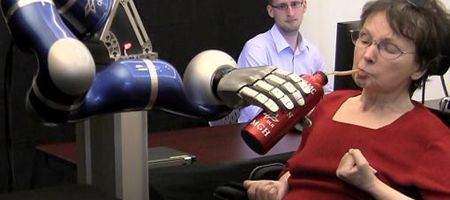Using thought alone, a paralyzed woman has been able to move a robotic arm to serve herself coffee for the first time in 15 years.

She’s one of two people to use the BrainGate neural interface system developed by the Department of Veterans Affairs, Brown University, Massachusetts General Hospital, Harvard Medical School and the German Aerospace Center (DLR) for three-dimensional movement.
Both the 58-year-old woman and the 66-year-old man had been paralyzed by a brainstem stroke years earlier which left them with no functional control of their limbs. But the woman was able to use a robot to pick up a bottle of coffee, bring it to her mouth, issue a command to tip it, drink through a straw and return the bottle to the table.
With the BrainGate system, a tiny device with a grid of 96 electrodes is implanted in the motor cortex. The electrodes are close enough to individual neurons to record their activity, which is translated by an external computer into commands.
It’s the first time such a system has been used to control three-dimensional movement.
“Our goal in this research is to develop technology that will restore independence and mobility for people with paralysis or limb loss,” says neurologist and neuroengineer Dr Leigh Hochberg.
“We have much more work to do, but the encouraging progress of this research is demonstrated not only in the reach-and-grasp data, but even more so in S3’s smile when she served herself coffee of her own volition for the first time in almost 15 years.”
The robotic arms responded to the participants’ intent to move as they imagined reaching for each target and grasping it.
In 158 trials over four days, the woman was able to touch the target within an allotted time 69.2 percent of the time with one of the robotic arms. The man managed it 95.6 percent of the time.
Using an eye-controlled communications system, he comments: “I just imagined moving my own arm and the [robotic] arm moved where I wanted it to go.”
The study used two advanced robotic arms: the DLR Light-Weight Robot III with DLR five-fingered hand and the DEKA Arm System, which has a wider grasp and produced the best results.
“We’ve moved significantly closer to returning everyday functions, like serving yourself a sip of coffee, usually performed effortlessly by the arm and hand, for people who are unable to move their own limbs,” says VA and Brown neuroscientist Donoghue.
“We are also encouraged to see useful control more than five years after implant of the BrainGate array in one of our participants. This work is a critical step toward realizing the long-term goal of creating a neurotechnology that will restore movement, control, and independence to people with paralysis or limb loss.”






